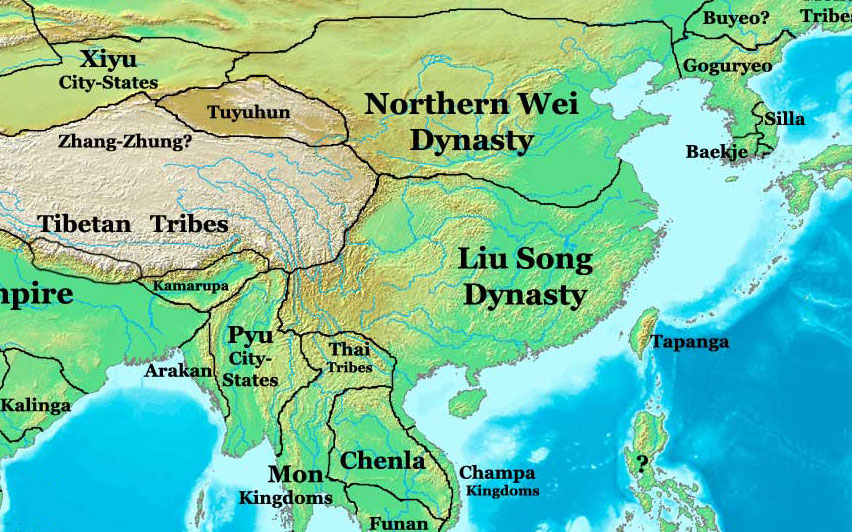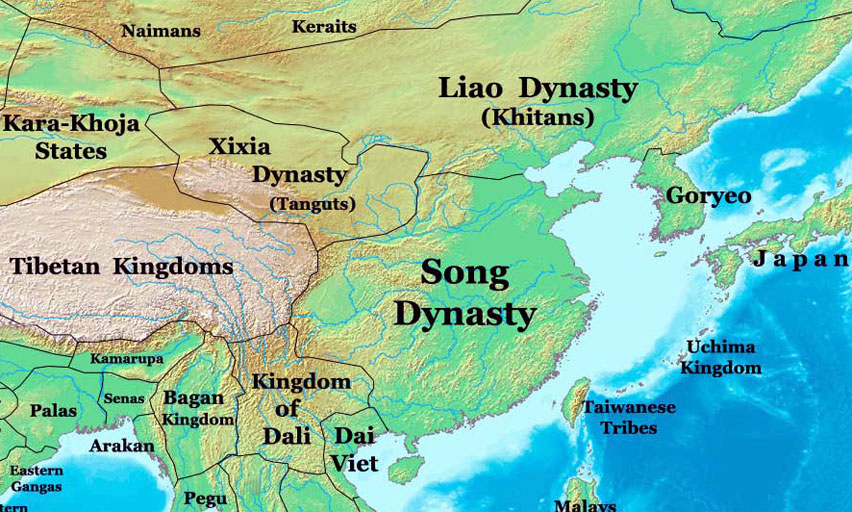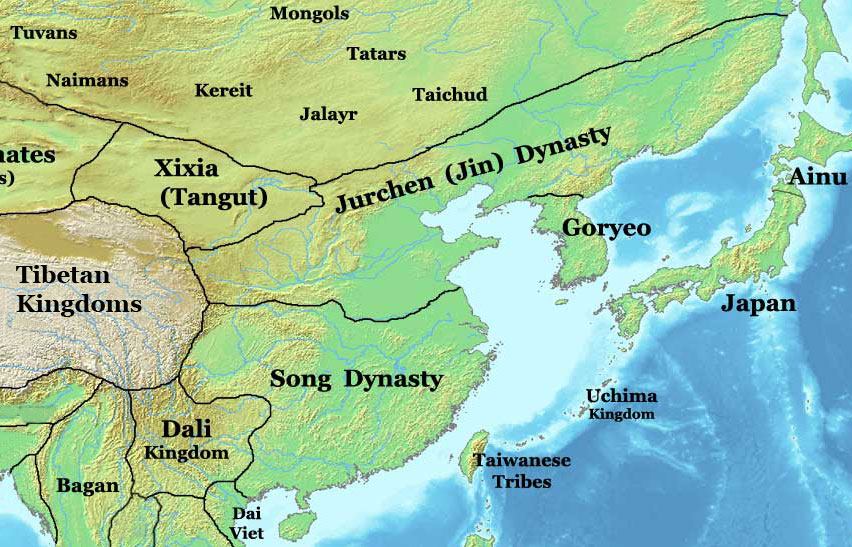For a long time, people (especially westerns) misunderstood Altaic people as Chinese subdivision. Often people were confused by Altaic people and Chinese. This page is to list such confusions and misleading terms and concepts. They need to be fixed. A main reason of such confusion was because non-Altaic (or non-Asian) people had difficulties in distinguishing Altaic people from Chinese. Also, through history, they had interactions and mixed in some part. However, two groups had completely different origins with distinct culture, identity, appearance, and language. Most of time, Altaic people remained huge influence on Chinese. Still lots of Altaic culture is mistakenly understood as Chinese culture. Understanding such Altaic influence on Chinese is important to clarify Altaic culture.
Altaic countries that colonized China
For a long time Altaic people governed and colonized China. Almost half of dynasties included in current Chinese history were non-Han Chinese dynaties. Also, Altaic people completely conquered China two times by Mongols and Manchus. Thus, Altaic influence on Chinese is huge. Current Chinese history cannot be completely separated from Altaic people's history. Due to this reasons, a lot of Altaic people and culture are mistakenly understood as Chinese. There are more non-Chinese culture and history in Ancient time. They should be clarified.
•304-439 Five Barbaric states and 16 countries (Tibettans, and Altaic people):
◦Another map: http://www.kknews.co.jp/wb/archives/images/五胡十六国.bmp
•386- 581 Northern Wei dynasty (Xianbei Altaic people)
•907-1125 Liao (Khitan Altaic people) : capital was Beijing
•1115-1234 Jin (Jurchen Altaic people): capital was Beijing
•1206-1368 Yuan (Mongol Altaic people): capital was Beijing
◦another map
•1616-1911 Qing (Manchu Altaic people): capital was Beijing
•1932-1945 Manchukuo and Japanese occupation on East China (Japanese and Manchu Altaic people):

304-439 Five Barbaric states and 16 countries (Tibettans, and Altaic people) (blue part on the map)

386- 581 Northern Wei dynasty (Xianbei Altaic people)

907-1125 Liao (Khitan Altaic people) : Beijing was the southern capital

1115-1234 Jin dynasty (Jurchen Altaic people): the capital was Beijing

1206-1368 Yuan dynasty (Mongol Altaic people): the capital was Beijing

1616-1911 Qing dyansty (Manchu Altaic people): the capital was Beijing
Genetic influence on Chinese
For a long time, Altaic people's genes infiltrated into Chinese gene. Due to this reason, genetic analysis often show some similarity to other Altaic people depending on regions. Mostly northern Chinese were heavily influenced by Altaic genes, so northern Chinese show more similarity to Altaic people than southern Chinese to Altaic people.
After collapse of Manchu empire Qing in 1912, Chinese got independence first time in 300 years expanding territory further north. After failure of the last Manchu state Manchukuo in 1945, China included Inner Mongolia and Machuria for the first time in history. Now China includes Altaic people homelands - Manchuria, Inner Mongolia, and Uygur. Chinese population in Manchuria grew fast becoming majority overwhelming native Manchu people. Many of native Manchu people and ethnic minorities changed their ethnics to Han Chinese.
Han chinese is the name of traditional Chinese occupying over 95% of Chinese population. But they are not a single ethnic. Nothern Han Chinese group and southern Han Chinese look clearly different and their native languages are also different. Originally, Han Chinese started history around Yellow River, and they didn't consider southern Chinese as the same ethnics. After Song dynasty, southern people were included but they were not called Han Chinese until Ming dynasty. Mongols' Yuan dynasty classified them with different names, Han people and Southern Song people.
Repeated Altaic conquests and long history of colonization on China deeply changed the original Chinese culture and their appearance. Current national historic institute of China concluded that original pure Han Chinese disappeared, and only cultural concept of Chinese remained [4 ].
Original Altaic culture that influenced Chinese
•Firearms and Gun pouder
- ◦People of Jin dynasty invented firearms using gunpowder for the first time, and they used firearms when Chinghis Khan (Mongol) invaded. But, It is wrongly known as Chinese invention to public. There is no clear evidence that gun powder was invented by Chinese. Only some records about ancient Chinese experiments showing smoke and fire were remained. but they were not connected to gun powder or firearms. Explosive materials was widespread across the world in early period before the firearms were invented. How Jurchens invented firearms is not clear. What current records say is that people of Jin dynasty used firearms for the first time. So, it should be understood as invention of Jin dynasty. The royal family of Jin dynasty was from Silla and Balhae (Korean conenctiont to Manchus). People of Jin were called Jurchens.
- ◦Chinese argument is that Jurchens are Chinese ethnic minority, so Jurchen's invention is also Chinese invention. But, Jurchens had not been called Chinese, and Jin dynasty had not been considered as Chinese history until 1980s. Jurchens were foreign ethnics to Chinese when firearms and gunpower was invented. After China occupied Tibet, Uygur, Inner Mongolia, and Manchuria in 1950s, China rewrote history to include all different ethnics living in the expanded territory. Chinese deviced a logic to include multiple ethnics in 1980s. "Han Chinese" is for the main stream ethnics, and "Chinese" for all ethnics living in China. As "American ethnics" doesn't make sense, "Chinese ethnics" including 56 ethnics is nonsense. It was political attempts to erase all ethnic minorities in China.
- ◦Mongol learned fire arms from Jin dyansty and transfered to western. It was also misunderstood as if Mongols learned it from Chinese. Mongols couldn't reach Song China until the collapse of Jin dynasty because Jin dynasty blocked Mongols from reaching China. Take a look at the map of Jin dynasty above.
- ◦During Mongol invasion on Jin dynasty, first ancient rocket was used. It is also misunderstood as Chinese invension.
•Jade
•Qipao
•The Forbidden City in Beijing
Chinese Culture Influenced by Altaic People
•Mandarin [1 ]
- ◦Mandarin became standard Chinese by Manchus during Qing dynasty. Before Qing dynasty, Chinese in each local province used their own native languages. Linguists classify them as different languages not dialects. Northern Chinese local languages show similarity to Altaic languages, and Southern Chinese native languages show similarity to Austro-asianic language.
- ◦Mandarin was native language only in East Liao province where is in western Manchuria. Some Chinese migrated to East Liao from Han danasty, and they were mixed with native Altaic people who lived there. Also, East Liao was out side of traditional Chinese land until China annexed Manchuria in 1946.
- ◦When Qing dynasty conquered China in 1644, Manchus brought people from East Liao and they helped Manchus to govern Chinese. Qing dynasty educated Chinese to learn this language in order to govern Chinese easily. But the Manchus efforts reached to only limited success because of Chinese resistance against Manchu invaders. Mandarin literally means the language spoken by the government.
- ◦After China got independence in 1912, China moved the capital from Nanjing to Beijing, and the language in Beijing became the standard language of China. So, Mandarin became the current standard language in China.
- ◦Altaic people never did Foot binding. It was exclusively done by Han Chinese. Manchu emperors tried to prevent Foot binding from Chinese during Qing dyansty, but failed. Chinese were scared that Altaic people take their women for a long time. The original reason of Chinese foot binding was to prevent northern invaders to take their women.
- ◦The current chinese explanation about foot binding that they thought small feet was beautiful was developed long time later. Chinese women with Foot binding couldn't work or ride a horse. Nomadic people couldn't take such women.
One misunderstanding widespread about Korean and Japanese is their connection to Chinese due to Chinese characters. It is often mistakely said (by Chinese) that their vocabulary is based on old Chinese characters, so they are also Chinese origin.
You are reading this thread using English alphabets which were from Roman letters originated from Greek alphabet. So, are you a Italian-origin? or are you a Greek-origin? This kind of nonsense is widespread understanding Korean and Japanese. Old Chinese characters were transferred to Korea and Japan with Buddhism. But Buddhism was NOT transferred by Chinese.
Buddhism was transferred to Guguryeo from Former Qin which was a Tibbettan coutry. Tibettans occupied north China and expanded the territory up to Goguryeo in 4th century. The Tibbetan ruler Fujian sent a Buddhist monk Sundo to Goguryeo to transfer Buddhism in 372. Korean Buddhism is often misunderstood as Chinese influence only because China expanded the land to whole Tibet in recent age. Korean Buddhism should be regarded as Tibettan influence, NOT Chinese.
Buddhism to Baekje was transfered by monk Marananta from Serindian in 384 which was over current Afghanistand and Uygur . Buddhism to Japan was transfered by Baekje with Kanji in 552.
Then why were Chinese characters used to transfer Buddhism? It is because a Chinese character represent a meaning instead of a sound. East Asians with different languages were able to communicate with characters representing meaning. Due to this reason Chinese characters were international characters in East Asia.
Chinese characters don't belong to only Chinese, but belong to all East Asians who used them.
Origin of Chinese
Recent genetic analysis unveiled that both North and South Chinese were from Southeast Asia (Myanma, Laos, Thai, Vietnam, ...), and spread to China around 10,000 years ago [2 ]. DNA analysis was performed by Chinese professors to see whether Chinese were evolved from apes in China or migrated from Africa. This study concluded that Chinese were migrated from East Africa to Southeast Asia (Myanma, Laos, Thai, ...), passed through Yunnan provinceand spread to China both north and south. This result was reported in The Beijingnews [2 ] and English People's Daily News [5 ]. Chinese who moved from south collided to Altaic people in North China, and North Chinese were heavily mixed with Altaic people after repeated conquests and colonization by Altaic people.
According to Wian Yida (袁義達), a researcher in Chinese Science Institute, the genetic difference between North and South Han Chinese is bigger than that of North Han Chinese and other ethnic minorities. It was concluded that Han Chinese don't have unique genetic identity, and only cultural identity remained as Chinese [3 ].
People of Southeast Asian countries (Myanma, Laos, Thai, Vietnam, ...) show similarity to Chinese culture including language. They are tonal language with SVO (Subject Verb Object) word sequence. Especially, the Burmese (language of Myanma) shows high similarity to Chinese. The current national Chinese language Mandarin was influenced by Manchu Altaic language. However, native Chinese languages show more similarity to Southeast Asian languages. Laos shows similarity to Han Chinese custom too.
The origin of Altaic people is known from Baikal lake and Altaic mountains in north Siberia. Altaic people (Korean, Mongol, and Manchus) lived around Baikal lake during glacial period, and moved to south 10,000 years ago. Altaic people were mainly evolved from Caspi see to Baikal lake passing Uralic and Altaic mountains. The genetic study of National Geographics unvailed that Altaic people's closest relatives are Iranian, Israelian, and Russians. Interestingly, Altaic people don't have any a common ancestor with Chinese until go back to Africa [6 ]. The distance between Altaic people and Chinese are bigger than that of all other races. The current similarity by genetic analysis is due to mix of them later. Chinese were heavily mixed with Altaic people.
Reference
[1] Stephen A. Wadley, "Altaic Influences on Beijing Dialect: The Manchu Case", The Journal of the American Oriental Society, Vol. 116, 1996
http://www.questia.com/googleScholar.qs ... 5001638952
[2] "DNA analysis on Chinese: The Beijing man of skull cannot be Chinese ancestor?", the Beijingnews, 2005, http://news.thebeijingnews.com/0197/200 ... @96905.htm
[3] "North and South Han Chinese are not the same ethnic?"http://big5.cri.cn/gate/big5/gb.cri.cn/ ... 288735.htm
[4] Associate Professor Xie East (Lanzhou University), "Pure Han people do not exist", Beijing News, 2007,http://tech.sina.com.cn/d/2007-02-15/08081385672.shtml
[5] "New Genetics Evidence Proves African Origin of Modern Chinese", People's daily, 2000,http://english.peopledaily.com.cn/20000 ... 573.html[6] "Altas of Human Journey", National Geogrpahics, https://genographic.nationalgeographic. ... atlas.html








